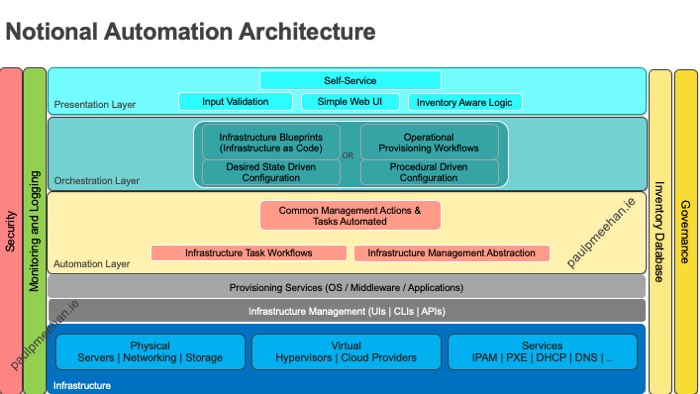How can anyone ever end up in Automation projects and discussions without being a developer ?
Hitachi Enterprise Cloud
Well, it can easily happen 🙂 and it started for me when I worked on the creation of the Hitachi Enterprise Cloud (HEC) offering four/five years ago. This is a bundling of:
- Hitachi Converged and Hyperconverged platforms including VMware Cloud Foundation.
- vRealize/vCloud Suite.
- A fully-Managed Service delivered by Hitachi Vantara.
- A commercial consumption model for virtual capacity units, currently called Everflex at Hitachi Vantara.
On the first project it was instantly clear that the missing piece (Number 5) in these projects is Automation. And in these projects, architecture design is much easier .
Automation is a nightmare. Why bother ?
Yes I believe this statement has some truth and merit in it, and any business large enough to consider full-scale automation of IT Services should ask it. The “why bother” part is critical. Just like an experienced architect talks about business value for a VMware architecture design and tries to link their solution to business outcomes and goals, this is critical with Automation – in fact many times more important. See some similar concepts here:
The Starting Point
The key statement that should be asked is:
What problem statement are you trying to solve. How will that bring value to your business ?
Most of us have written scripts in PowerCLI, Powershell, Perl and for some old guys like me, Bourne Shell scripts on Solaris.
However, That is not automation from the perspective of end-to-end service provisioning and consumption. it is mostly automating repeatable tasks or just time-consuming tasks that save an administrator time. This is “task-oriented”.
What is Real Automation?
Ask yourself what’s missing ? Well, for a business to regard it as really adding value you need to consider how it enhances IT Services offered to the business including Provisioning models, Reduction in Total Cost of Ownership of IT assets, achieving a Return on Investment on the cost of service enhancement. Also, will it lead to SLA improvements, provide agility, optimise operations or offer other opportunities for Digital Transformation.
These are not just buzzwords – imagine shortening the deployment of ESXi clusters with attached storage from 6-8 weeks, very common!, to 2/3 hours for consumption by application users. That is agility and streamlining previously restrictive operational models, using automation.
Automation Conceptual Model
This is a slide that one of my colleagues put together (I just provided a couple of ideas).

It helps present some of the considerations in an Automation Conceptual Model. I will be exploring many of these connected parts such as Inventory Databases, use of different blueprinting tools and benefits of infrastructure blueprints (IaC) versus traditional workflows. There is a place for both and I will give examples.
Having been involved in this area for a few years now, my opinion is that for automation to become fundamental to improving IT Service, there must be a business process that needs to surround the task.
- Think Task Automation = Step
- Think End-to-end Service = Process.
Traditional workflows based on vRealize Orchestrator or Hitachi Ops Center Automator are a small part of the picture for fully-integrated automation. And …. There could be many automation processes for different consumers or layers – some for Iaas, some for SaaS. It depends, and all of these (in my experience) can have different automation frameworks and tooling in play.
Orchestrate, don’t just Automate
Orchestration is the key.
A conductor orchestrates people who already know their lines; he doesn’t need to tell them what notes to play, just how to work as part of the overall team/process/tune, building towards an eventual outcome in a symphony etc. In the same way Orchestrating automation is the key to success for an overall end-to-end process, and understanding the dependencies, integration points, inputs, output, rollback considerations and many other things are key.
I will delve into many of these ideas in later posts.
Until then …..
5,769 total views, 2 views today
